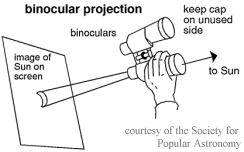|
Never view the
Sun directly with the naked eye or with any unfiltered optical
device, such as binoculars or a telescope!
Click
here for a Spanish version of this page
If you're thinking of viewing the Sun, your first
concern should always be eye safety. Serious eye
damage can result from even a brief glimpse of our star.
 One
safe way to observe sunspots
or eclipses
is to project an image of the Sun through a telescope or binoculars
onto a white screen -- paper plates, walls and sidewalks all
work nicely. If you're using a telescope, be sure that any small
finder telescope is capped. If you're using binoculars, keep
the cover on one of the two tubes. Never look through
a telescope or binoculars to point them at the Sun -- partial
or total blindness will almost surely result. One
safe way to observe sunspots
or eclipses
is to project an image of the Sun through a telescope or binoculars
onto a white screen -- paper plates, walls and sidewalks all
work nicely. If you're using a telescope, be sure that any small
finder telescope is capped. If you're using binoculars, keep
the cover on one of the two tubes. Never look through
a telescope or binoculars to point them at the Sun -- partial
or total blindness will almost surely result.
On the screen you should see a bright circle of light. This is
the disc of the Sun. Adjust the distance between the screen and
the telescope until the disk is about the size of a small paper
plate. The image will probably be blurred; focus your telescope
until the circle becomes sharp. Using this method you can see
considerable detail in and around sunspot groups.
Pinhole projectors
and certain types of solar
filters can also afford a safe view of the Sun. Pinhole projectors
usually produce a small and unsatisfying image, but they are
better than nothing if you don't have a telescope or binoculars.
Web links:
|


 One
safe way to observe
One
safe way to observe